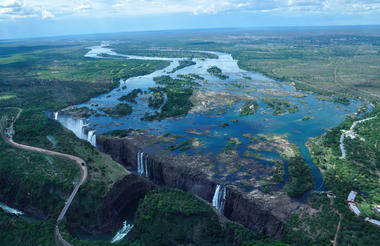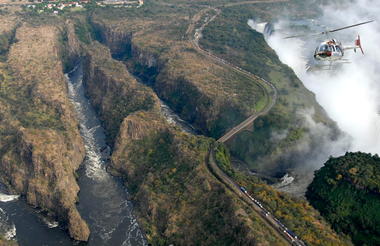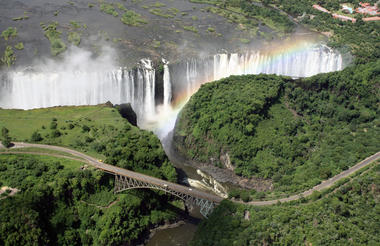Understandably one of the wonders of the world, Victoria Falls is the principal tourist attraction in Zimbabwe.
The force of the mighty Zambezi River spilling into a gorge is one of the most enthralling sights in the world.
The local Makololo name for the falls is 'Mosi-ao-Tunya' which means the Smoke that Thunders. UNESCO recognised the significance of the falls and the surrounding area and gave it the World Heritage Site credential in 1989.
Victoria Falls town is where the tourist adventure starts. It lies on the south bank of the river close to the falls. It is served by a recently-upgraded international airport that has opened up the possibilities of direct linkages with the world. There are also rail and road connections from the town to the rest of the country.
During different eras the river has fallen into different chasms, which now look like a series of sharp zigzag gorges downstream from the falls. There are 7 recognised gorges, the First, Second, Third, Fourth, Fifth, Songwe and the Batoka gorge across which the gorge swing activity takes place.
There is an array of activities that can be done below and above the falls and on the Zambezi. Whitewater rafting, river boarding, bungee jumping, abseiling and .... are the adrenaline-pumping activities that can be done here. For more relaxing activities, sunset cruises and canoeing can be done on the Upper Zambezi for the rich wildlife in the area or elephant rides, walking safaris and horseback trails can be booked in the surrounding national parks and smaller wilderness areas.
A part of the Upper Zambezi forms the Zambezi National Park, which together with the Victoria Falls National Park, the spray-drenched rainforest, covers an area of 56,000 ha.
The Zambezi National Park is stunningly wild and the tourist will surely quench his thirst for the most extravagant of visits to see large mammals, smaller mammals, almost 400 species of birds, beautiful forests of mahogany, figs and date palm trees and extraordinary views of the roaring falls from the Victoria Falls National Park.



VintageAirRally
Sunset Cruise Victoria Falls Helipad DinnerVictoria Falls Vintage Air Show
Puma Energy Gala Dinner34 km south of Bulawayo is the extraordinary Matobo Hills National Park that is situated in the 80 km long Matobo Hills. Formerly known as the Rhodes Matopos National Park, this 424 sq km national park is one of the more accessible and interesting areas in Zimbabwe.
The dramatic landscape of this park is made of huge piles of granite boulders with reddish hues balancing on top of each other at improbable angles. The 200-milliom years old Matobo Hills has range of domes, spires and balancing rocks resultant of years of erosion of a solid granite plateau.
The park was founded in 1953 but got the UNESCO World Heritage status in 2003 for having one of the largest concentrations of rock art in Southern Africa. These 3000 fine rock paintings are the legacy of the San (Bushmen) hunter-gatherers who lived here about 2000 years ago.
There are beautiful paintings of giraffe, eland, kudu and rhinos in the caves. The identification of a rhinoceros outline at the White Rhino Shelter gave the impetus to reintroducing the species to the park in the 1960s. There is a large population of white and black rhino in the park along with zebra, wildebeest, kudu, giraffe, sable, klipspringer, hyena, cheetah, hippo, leopard, common duiker, crocodiles, waterbuck, baboons and vervet monkeys.
Matobo was named by the Ndebele King Mzilikazi after the 'bald' rocks (amaTobom means 'bald heads' in Ndebele). He was buried in the hills just a short distance to from the park. The local people consider the site sacred and still use them for their traditional ceremonies. The summit of Malindizimu in the hills is also the place of burial of the imperialist Cecil John Rhodes who referred to it as 'World's View'. Also buried here are his right hand man and leader of the Jameson Raid Leander Starr Jameson and first Prime Minister of Rhodesia Charles Coghlan.
There is no public transport to the park but it is easy to drive to the park and around. From Bulawayo, the drive out of the city is via the Robert Mugabe Avenue.
There are private camps just outside the border of the park for accommodation and National Park chalets. The National Park is divided into different areas including the Lake Matopos, Recreational Park Area, Sandy Spruit and the Whovi Wilderness Area where the rhinos are. These areas of wilderness are truly spectacular with high biodiversity; there are over 200 species of trees, fairly rich bird-life especially black eagles, multi-coloured lizards, snakes and game. The caves housing the rock paintings are easily accessible and each has a unique setting in the granite wilderness.
Matobo Hills National Park is a safe walking terrain. With beautiful scenery around, it offers excellent hiking opportunities. Short walks include the Lakeside walk, Maleme Dam from Fish Eagle lodge, Mount Pomongwe from Maleme Camp, Maleme camp to Pomongwe cave while longer walks can be climbing mount Shumbashawa near Gordon Park, climbing Nyahwe mountain and hiking from Toghwana Dam to Inanke Cave. Most of the trails pass along the caves with rock paintings. A guide can accompany you from the Maleme Camp if required.
Other than hikes, visitors can also try their luck at tracking rhinos on a guided walking tour with an armed scout. With an ever-increasing population of black and white rhinos , you can more often than not spot them easily. Also a 4 WD can be taken to spot more wildlife at a leisurely pace.






